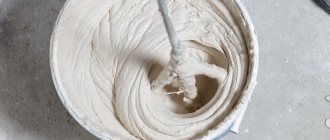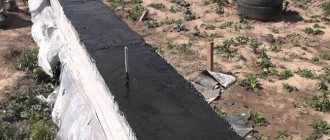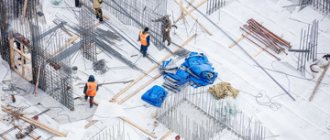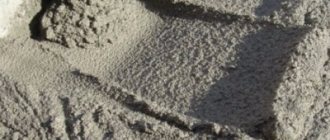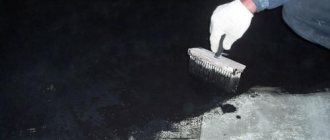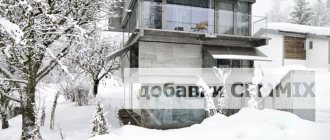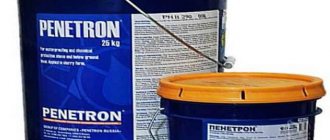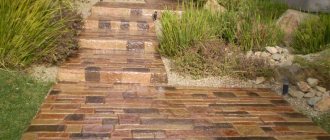Waterproof concrete - what is it?
Moisture-resistant reinforced concrete is a special type of material in which there are no pores and capillaries (voids) that allow the bulk of moisture to pass through. The material is characterized by increased density , which determines its specific properties, but this is not enough to ensure complete waterproofing.
Water resistance classes
The grade of concrete related to the degree of waterproofness is indicated by the letter “W” followed by a numerical value. The number can range from 2 to 20 and determines the maximum permissible fluid pressure.
Concrete with maximum water resistance is labeled W20 and vice versa. In private housing construction, it is enough to use material W4-W8 , but if groundwater is close, this figure can be increased to W12.
When carrying out work, it is necessary to prepare a special concrete solution and seal the joints
Concrete grades for water resistance
Depending on the degree of water resistance, concrete is divided into ten main grades (GOST 26633). They are designated by the Latin letter W with a specific digital value indicating the maximum water pressure that a cylindrical test concrete sample 15 cm high can withstand during special tests.
The water resistance of concrete is determined by direct and indirect indicators of its interaction with water. Direct indicators are the brand of concrete and its filtration coefficient, and indirect indicators are indicators of the water-cement ratio and water absorption by mass.
In private and commercial construction practice, to find out the water resistance of concrete, they pay attention to its brand, and other criteria are important mainly in the production of this building material.
Do-it-yourself concrete additives for waterproofing
Special materials increase the density of reinforced concrete and eliminate any penetration of moisture (pressure, capillary).
Additives are classified as follows:
- polymer;
- plasticizing;
- clogging.
Plasticizers
The materials differ in quality, but have the same operating principle:
- Most compositions, entering the solution, form a film coating that envelops the cement particles and determines their characteristics. They become slippery and help improve the mobility of reinforced concrete;
- Some plasticizer systems generate an electrical charge, activating the solution particles, which also improves the fluidity of the mixture.
- Polycarboxylic compounds have been developed with a combined principle of action, simultaneously forming a charge and a film. Ready-made concrete gains strength, frost resistance, water resistance, and density.
Plasticizer C3
The use of the material is permissible on prefabricated and monolithic structures with a high degree of reinforcement. The proportion of the substance is calculated based on the mass of dry cement and is 0.3-0.8% of its weight . The additive is introduced into the mixture after dilution in water, according to the selected technology.
Cooking recommendations:
- the solution is mixed at positive air temperatures;
- the container must be clean;
- during dissolution, constant stirring is performed;
- When working, personal protective equipment is used.
Material advantages:
- saving cement;
- increasing the mobility of concrete and reinforced concrete products without compromising strength;
- the freshly laid mixture does not need to be vibrated;
- the finished composition is characterized by increased density, which improves water resistance;
- high frost resistance;
- reduction of shrinkage.
When work is carried out with your own hands, it is advisable to use special additives that are proportionally introduced into the working mixture
Colmatizing
The principle of operation of the compositions of this brand is revealed as follows:
- reinforced concrete is compacted after the solution hardens;
- a strong chemical reaction occurs between the components of the additive, water and cement particles;
- the substances formed are insoluble high-strength compounds that fill voids in solid concrete;
- The basis of all mixtures with bridging properties is microsilica.
Polymer
Polymer compositions determine the mobility of the concrete mass : a film is formed on the particles of the mixture. Such materials make it possible to ensure high moisture resistance even for those structures that have already become damaged.
Penetrating waterproofing
Additives with penetrating action help to obtain a high effect. They can be applied to hardened concrete or injected directly into the solution. The composition of the mixtures varies depending on the manufacturer.
Systems in which sand and cement predominate form a crust; bases with chemical compounds penetrate deeper into concrete, that is, they fill voids and pores more effectively.
"Penetron"
The main representative of penetrating waterproofing.
Material properties:
- ensuring water resistance of reinforced concrete and concrete structures at the concreting stage;
- application extends to prefabricated and monolithic structures, including those with cracks and pores. These could be swimming pools, tanks, basements, foundations, septic tanks;
- compatibility - additives are used in concrete for strength, which are not difficult to buy;
- radioactive safety, environmental friendliness;
- the composition is represented by chemical additives, granulometric quartz sand and special cement;
- increasing the frost resistance of hydraulic concrete;
- protection of the structure from wastewater, groundwater, alkalis, acids, including sea water.
"Penetron Admix" is dissolved in water and added to the concrete mixture at the mixing stage. To carry out waterproofing of communication inputs, connections, seams, joints, additional waterproofing gaskets are laid
To install waterproofing, it is recommended to follow the following sequence of actions::
- the concrete base is cleared of all materials that could serve as an obstacle to the penetration of active chemicals. For work, you can use a high-pressure water jet or a brush with metal bristles;
- surfaces that have been sanded are moistened with a weak acid solution, which is washed off with water for an hour;
- before applying the system, the concrete surface is moistened;
- the finished solution is applied in two layers to the base using a brush with synthetic bristles;
- the second layer is applied to the set first layer, which is also moistened;
- the surface must be processed evenly, without gaps.
How to make waterproof concrete with your own hands?
There are several types of waterproofing additives for concrete on the market:
- The mixture is dry with an expanding effect. They are introduced into cracks in already hardened concrete, where they expand and become a single monolithic mass;
- The mixture is dry with a penetrating effect - they are added to the solution at the manufacturing stage;
- Dry mixtures with an expanding effect for application to the surface of freshly poured concrete;
- Pressure sealant. This product is not added to the concrete mixture. They usually cover the surface in places where the concrete has cracked.
Liquid glass - modern waterproofing
A type of silicate adhesive improves the performance characteristics of reinforced concrete products without significantly affecting their cost.
The material allows you to provide:
- waterproof;
- moisture resistance;
- heat resistance;
- resistance to fungal and mold attacks.
Liquid glass for concrete is used in the construction of foundations, including for hydraulic engineering, fireplaces, boilers, furnaces, and various underground reinforced concrete structures.
Self-construction involves using the following principles:
- at least 10% silicate glue is introduced into the concrete solution, which ensures optimal technical characteristics;
- silicates are not added to the finished solution. First, the dry components are combined, then glue is introduced, which is previously diluted with water;
- It is recommended to prepare solutions in small portions, since the additive accelerates hardening. Laying and pouring reinforced concrete should be carried out quickly.
For work, it is advisable to use concrete grades M400/M200. Failure to comply with the proportions will result in the finished structure falling apart the next day.
Sequencing:
- a glass of liquid glass is diluted in a bucket of purified water;
- the solution is thoroughly mixed;
- the additive is poured into a more convenient container, for example, a trough, and the dry mixture is introduced there;
- the mass is processed with a construction mixer;
- Do-it-yourself waterproof concrete is ready and can be poured into the formwork.
Waterproofing of finished reinforced concrete products is carried out using a primer with silicate glue. In private construction, a mixture of water, cement and liquid glass (1 liter of water/400 g of glue) is used for such purposes.
Elimination of concrete shrinkage process
Low and medium grade concretes are quite porous materials that easily absorb moisture. This negative property increases during the process of shrinkage of the solution during solidification. Thus, the quality and waterproofness of a concrete mixture can be improved by reducing the degree of its shrinkage.
An integrated approach will help you achieve the desired result:
It is necessary to use special additives in concrete for waterproofing. The principle of their operation is that when the solution hardens, they form a protective film that prevents its shrinkage.
Today, there are various additives in concrete for waterproofing on the market, and although they have the same task, each individual option has its own characteristics, so before purchasing you should carefully read the manufacturer’s instructions. In addition to the fact that special additives are added to concrete for waterproofing, It is also recommended to water it with water. This procedure is performed during the first four days at intervals of 4 hours. Next, the concrete structure must dry under natural conditions. With the rapid evaporation of moisture from the solution during hardening, unwanted shrinkage also occurs.
To slow down this process, after pouring a concrete structure, it must be immediately covered with a special film, under which condensation will form, preventing shrinkage and helping to increase the strength of concrete. The coating is positioned so that it does not touch the fill. Small gaps are left along the edges for air ventilation.
Waterproofing the basement from the inside from groundwater
Vertical waterproofing is carried out along the basement part of the structure in cases where the walls of the structure are located at the groundwater level and in the absence of a drainage system. Horizontal is implemented on the floor - when the base is placed at the groundwater level.
The choice of work method is made based on the following parameters:
- foundation material, insulation quality;
- precipitation level and groundwater occurrence;
- purpose of the premises;
- presence of drainage systems.
General principles of work:
- if the basement is flooded, the water is pumped out or you need to wait until it goes away on its own;
- the surface is cleaned down to the concrete base.
- cracks must be grooved and cleaned for deeper penetration of waterproofing systems;
- reinforcement fabric secured to the base with dowels will enhance moisture resistance;
- when strengthening the horizontal plane, it is filled with crushed stone and cemented, the insulation extends onto the walls up to 300 mm.
Features of different brands
The permeability of a concrete mixture is expressed by indirect and direct parameters. The latter includes the filtration coefficient and the grade of concrete for water resistance. Indirect indicators are the water-cement ratio and water absorption. Thus, there is a specific table for the water resistance of concrete:
- Concrete, which is marked W2, corresponds to M150-M250 cement, which quickly absorbs moisture and, regardless of the thickness of the layer, requires the application of waterproofing.
- Concrete composition W4 corresponds to the cement grade M250-M350. It is less susceptible to moisture, unlike W2, but is quite hygroscopic. Recommended for use with a waterproofing layer. The material is used in traditional construction. The water resistance indicator increases during the introduction of ingredients and additives into the prepared concrete composition that cause compaction of the mass, as well as the use of cements with a high expansion rate.
- Concrete mortar W6 (corresponds to M350) is characterized by lower moisture permeability, which makes it possible to widely use it during construction. Excellent water resistance allows the composition to be used for sealing cracks in reinforced concrete and monolithic structures for waterproofing tanks. It is also used for the construction of basements on the ground where underground water is close.
- The W8 concrete composition is made from high-quality M400 cement. The W8's water resistance is approximately 5% moisture by weight. Concrete has shown itself to be excellent during the work of pouring the foundation, constructing tanks and containers that are used for storing liquids, bomb shelters, as well as various hydraulic structures. It is used in traditional construction if it is necessary to carry out work on the construction of a structure that will be operated in high humidity.
- Solutions W10−20 (M450−600) are characterized by maximum water resistance and do not require a waterproofing layer during application. The scope of use of these compounds is the construction of hydraulic structures, liquid storage tanks, as well as other special tanks. Concrete W20 has the greatest resistance to water; it is not used in private construction. The solution is characterized by high frost resistance F250-F350, which allows it to withstand significant temperature differences.
Improved performance
The task of increasing the water resistance of a concrete mixture is relevant both during civil and industrial construction, and during the corresponding work in private buildings. Since not all the time, when carrying out concrete work, it is possible to purchase high-quality cement.
There are effective methods that make it possible to achieve increased stability , complicating the penetration of moisture through hardened concrete:
- The use of coating materials, which are hot bitumen, emulsions, mastics, applied to a cleaned, primed surface. The coating is done layer by layer until a thick protective film appears. The use of a waterproofing paint layer method makes it possible to protect the surface for a limited time.
- Keeping products under special conditions. Proper storage, which implies the absence of direct sunlight, constant temperature, acceptable humidity. This increases the property of the material to resist moisture. With increasing storage time, the composition gains increased strength.
- Preventing rapid shrinkage of the mass during hardening, which is due to the presence of an increased content of air cavities. It is through them that water enters the thickness of the material. The use of additives promotes the formation of a protective layer on the surface of the array, which reduces shrinkage. Maintaining volume can be facilitated by moistening the concrete with water during the first week of hardening and using a film that makes it difficult for water to evaporate.
